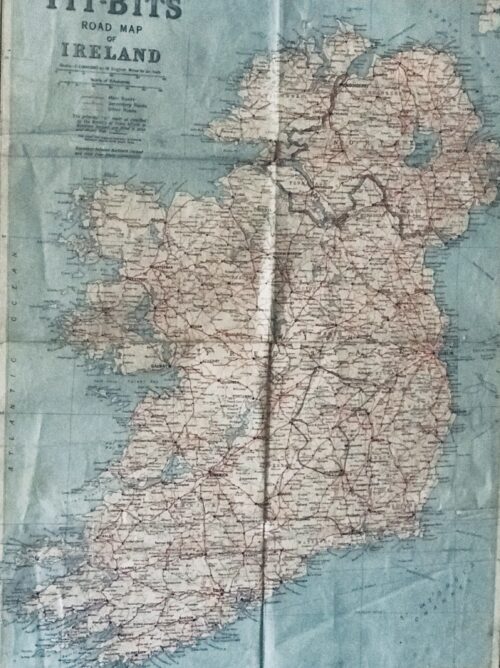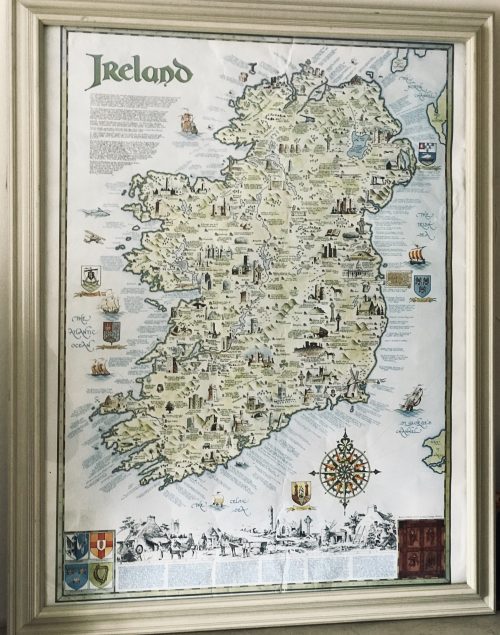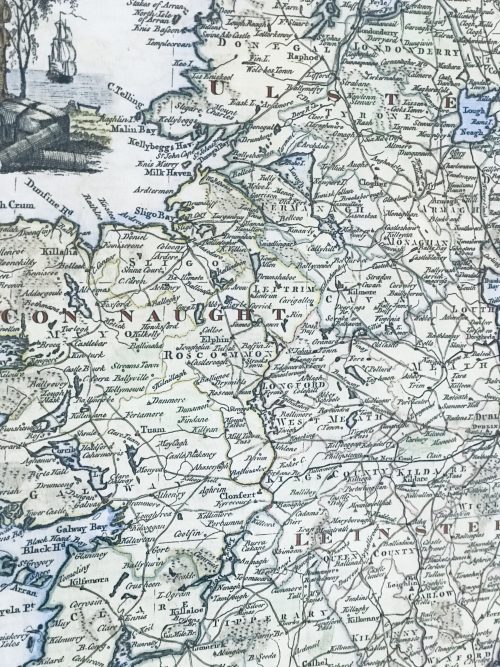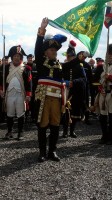-

 Very interesting map of Co Limerick from the 1825 surveys by the well known cartographer James Coffey.From the Latest Surveys. By James Coffey. 1825. Engraved by Sidney Hall, Bury Street, Bloomsbury. Published and sold by George McKern, 106, George Street, Limerick. Scale in Irish and English Miles. Framed and glazed. Bruree Co Limerick 45cm x 60cm
Very interesting map of Co Limerick from the 1825 surveys by the well known cartographer James Coffey.From the Latest Surveys. By James Coffey. 1825. Engraved by Sidney Hall, Bury Street, Bloomsbury. Published and sold by George McKern, 106, George Street, Limerick. Scale in Irish and English Miles. Framed and glazed. Bruree Co Limerick 45cm x 60cm -

 Interesting old display print on a wooden background depicting the historical,cultural and sporting highlights of the Emerald Isle.Although the frame is showing signs of age related wear,this piece will make a wonderful addition to your collection or decorative item for your wall . Kilkee Co Clare 60cm x 55cm
Interesting old display print on a wooden background depicting the historical,cultural and sporting highlights of the Emerald Isle.Although the frame is showing signs of age related wear,this piece will make a wonderful addition to your collection or decorative item for your wall . Kilkee Co Clare 60cm x 55cm -

 Clonakilty Co Cork 80cm x 56cm Superb retro/vintage Paddy Irish Whiskey selling the touristic delights of the emerald Isle along with the undoubted merits of Paddy Old Irish Whiskey.The Bord Fáilte logo can be clearly seen at the bottom of the poster also.Each part of the country has its own attractions carefully illustrated .A beautiful keepsake of a bygone era.
Clonakilty Co Cork 80cm x 56cm Superb retro/vintage Paddy Irish Whiskey selling the touristic delights of the emerald Isle along with the undoubted merits of Paddy Old Irish Whiskey.The Bord Fáilte logo can be clearly seen at the bottom of the poster also.Each part of the country has its own attractions carefully illustrated .A beautiful keepsake of a bygone era.
Paddy is a brand of blended Irish whiskey produced by Irish Distillers, at the Midleton distillery in County Cork, on behalf of Sazerac, a privately held American company. Irish distillers owned the brand until its sale to Sazerac in 2016. As of 2016, Paddy is the fourth largest selling Irish whiskey in the WorldHistory The Cork Distilleries Company was founded in 1867 to merge four existing distilleries in Cork city (the North Mall, the Green, Watercourse Road, and Daly's) under the control of one group.A fifth distillery, the Midleton distillery, joined the group soon after in 1868. In 1882, the company hired a young Corkman called Paddy Flaherty as a salesman. Flaherty travelled the pubs of Cork marketing the company's unwieldy named "Cork Distilleries Company Old Irish Whiskey".His sales techniques (which including free rounds of drinks for customers) were so good, that when publicans ran low on stock they would write the distillery to reorder cases of "Paddy Flaherty's whiskey". In 1912, with his name having become synonymous with the whiskey, the distillery officially renamed the whiskey Paddy Irish Whiskey in his honour. In 1920s and 1930s in Ireland, whiskey was sold in casks from the distillery to wholesalers, who would in turn sell it on to publicans.To prevent fluctuations in quality due to middlemen diluting their casks, Cork Distilleries Company decided to bottle their own whiskey known as Paddy, becoming one of the first to do so. In 1988, following an unsolicited takeover offer by Grand Metropolitan, Irish Distillers approached Pernod Ricard and subsequently became a subsidiary of the French drinks conglomerate, following a friendly takeover bid. In 2016, Pernod Ricard sold the Paddy brand to Sazerac, a privately held American firm for an undisclosed fee. Pernod Ricard stated that the sale was in order "simplify" their portfolio, and allow for more targeted investment in their other Irish whiskey brands, such as Jameson and Powers. At the time of the sale, Paddy was the fourth largest selling Irish whiskey brand in the world, with sales of 200,000 9-litre cases per annum, across 28 countries worldwide. Paddy whiskey is distilled three times and matured in oak casks for up to seven years.Compared with other Irish whiskeys, Paddy has a comparatively low pot still content and a high malt content in its blend. Jim Murray, author of the Whiskey bible, has rated Paddy as "one of the softest of all Ireland's whiskeys".

Introduced 1879, renamed as Paddy in 1912 -


Worldwide Duty Free selling is a $70 billion business, but it has its origins in the mind of one Clare man. And like many innovations, the concept of duty free, which first came to Shannon Airport in 1952, was born of necessity.Today the global travel retail business is a firm fixture at airports across the world, and the concept has made a lot of money for a lot of people.But not for Brendan O’Regan, the man with the idea.
He was born into “the first generation of free Irish men” in relatively well-off surroundings in Sixmilebridge, Co Clare in 1917. His father, James, was chairman of Clare County Council and a successful businessman. The family was in the hotel business, and for a time leased the renowned Falls Hotel in Ennistymon and the Old Ground in Ennis. Sent as a boarder to Blackrock College in Dublin in 1931, O’Regan enjoyed early renown when he requested that the college, which by then had given up on the camán, field a hurling team in the Leinster Colleges cup.
His next step after school was training in hotel management, an interest that brought him to Germany, France and the UK, before coming home to run The Falls. He then moved to the ailing St Stephen’s Green club in Dublin, before being appointed catering comptroller at Foynes flying boat base in Co Limerick, then a refuelling point for transatlantic seaplanes.
It was here his passion for travel took off, but it was his next move that sealed his legacy.
Shannon Airport
Rineanna on the Shannon estuary in Co Clare, chosen by then taoiseach Seán Lemass as the site for a new airport for both sea and land planes, opened in October 1945, when the first transatlantic commercial air service from Boston landed there. It soon became Europe’s most important transatlantic airport, handling more than 100,000 passengers in 1946, its first full year of operation.
When O’Regan joined the nascent airport, its future was by no means secure. The imminent arrival of jet planes, which meant US planes would no longer have to stop in Shannon to refuel, was of concern, while the political apparatus of the day favoured focusing efforts on one airport in Dublin.
Fearing “economic annihilation” for the new airport, O’Regan sought a new venture that would help secure its future. Inspiration struck when he was returning home by sea from a visit to the United States, arranged under the Marshall Plan to allow the Irish government to study US tourism.
As told in the recently published book Brendan O’Regan: Irish Innovator, Visionary and Peacemaker by Brian O’Connell and Cian O’Carroll, O’Regan had a “eureka” moment on board.
“I saw the shop that was selling duty-free goods and my brain said to me: “If they can do it when you are crossing the sea in a boat, you can surely be able to do [it] when you land for the first time.”
He had to convince the Department of Industry and Commerce and the Revenue Commissioners of the merits of forgoing tax on the sale of goods, while local traders also opposed the move.
Nonetheless, O’Regan got the go-ahead and by July 1950 he had set up an operation in a timber hut outside the terminal, selling whiskey for $1.50 a bottle. The following year, the first duty-free shop in the world opened, with a bottle of whiskey on sale for just 30s, compared with 10s 6d in a regular shop, while in 1954 a mail order service was included. It went on to become a vast operation, mailing to locations all around the world, quality items such as crystal, china, fashionable clothing and jewellery.
Contagious idea
The concept soon caught on. In 1957 Amsterdam became the next airport to open a duty free, with the concept making its way across the Atlantic in 1962. Prince Philip was an early admirer of the concept, and he wanted it extended to all the UK’s international airports.
O’Regan also inspired philanthropist Chuck Feeney, who took the idea of duty free and galloped ahead with it, founding Duty Free Shoppers Group (DFS) in Hawaii in 1962, which later became the largest duty-free retailer in the world.
These years also saw the invention of Irish coffee, after O’Regan asked chef Joe Sheridan to “come up with something special” to warm up transatlantic passengers tired and cold after their trip.
But duty free was only part of the equation. O’Regan’s big dream was to position Shannon as the European manufacturing basis for US companies, and to bring employment and prosperity to the region.

Senator TK Whitaker, Brendan O’Regan (centre) and Dr Jerry Dempsey. Photograph: Peter Thursfield Shaped by the devastating impact poverty and emigration had on the county of his birth, O’Regan often repeated his father’s maxim, that “the most important thing about life is to create work for others, if you can”.
In the 1950s, the post-war boom that lifted the US, Europe and the UK had missed Ireland, and emigration was running at the highest level since independence.
So O’Regan didn’t stop at the duty free.
In 1951, he established the Shannon College of Hotel Management, which is still operating today and the graduates of which have managed the world’s top hotels, while he also leveraged the area’s potential as a tourist hub. He identified the potential of Bunratty Castle as a tourist attraction and, with the co-operation of its owner, Lord Gort, it was renovated and opened to the public in 1960, with the first medieval banquet held shortly thereafter. O’Regan later chaired Bord Fáilte.
Great times
“He was very much a leader and innovative in the sense that he thought up ideas himself,” recalls O’Carroll, who worked alongside O’Regan as estates manager in the Shannon Free Airport Development Company Limited (SFADCO). “He would work very intensively until the project was launched, and then he would go on to the next project”.
It was a time of “brainstorming picnics”, and consultancy reports, to try and hit on a new idea.
“They were great times,” says O’Carroll. “If an idea came up, and it was any way worthwhile, it would stand a very good chance of implementation.”
The big move came in the establishment of the Shannon Free Zone, the world’s first free trade zone, in 1959, overseen by SFADCO. It operated a licensing system, offering qualifying companies a corporation tax rate of just 10 per cent; a model that would later be taken up by the IFSC.
O’Regan’s idea, inspired by the Free Zone in Colon, Panama, was greeted with much scepticism initially, but his ability to build good relationships, particularly with those in government, helped secure the initiative.
“He had the ability to short-circuit a lot of things in terms of procedures in getting approval,” says O’Carroll, adding that “this clearly annoyed civil servants at the time.”
Indeed his initials, BOR, in Shannon came to mean “Bash on regardless”.
So, on an “if you build it they will come” ambition, SFADCO set about building factories – without any tenants. A Dutch piano manufacturer owned by Johan J Rippen was the first real enterprise to come to Shannon, followed by Sony, and diamond company De Beers in 1960.
Tourism smarts
O’Regan also ramped up the region’s renown as a tourist destination, using his tools of persuasion to garner investment.
When Bernard McDonough, a wealthy Irish-American industrialist pulled out of a planned ball-bearing factory in the Shannon Free Zone, O’Regan told him about a nearby castle that was for sale. He took the bait and bought it; in 1963 Dromoland Castle opened as a five-star hotel. McDonough would later open a further three hotels in the area.
When he heard of a plan by German investors to acquire the land leading to the Cliffs of Moher, he rang then Clare county manager Joe Boland, who subsequently got the county council to buy it.
During the 1970s he moved away from his formal roles in Shannon, and turned his attention to the peace process, founding Co-operation North (now Co-operation Ireland) in 1979. He died in 2008, and a bronze bust sculpture was unveiled at Shannon Airport in May 2017 to mark the centenary of his birth.
A man of his time – as O’Carroll recalls, an “infinitely simpler” time – he nonetheless left a significant legacy.
As described when receiving an honorary degree from the National University of Ireland in 1978: “Rare is the man of whom it can be justly said that he transformed the social, economic and industrial life of a whole region”
The Shannon project was not just about creating jobs; it was also about providing homes for the workers who flocked there.
By the late 1950s the housing issue, which had plagued the development of the hub since the early days, was becoming a crisis. So, in 1960, a proposal was tabled for the creation of a new town; an innovation without precedent in post-war Ireland.
Inspired by the British new towns that arose after the war, including Crawleyin Sussex and Stevenage in Hertfordshire, Brendan O’Regan and his team sought to build a new hub for workers of the airport and the industrial zone.
The creation of the first new town in the history of the State was not without challenges; there were political ructions as to who would oversee the project – the government or SFADCO – while residents of nearby Limerick city accused Brendan O’Regan of “empire building”, as they rued the fact that the development did not happen in Limerick instead.
Nonetheless, by 1962 the first residents were moving in, all of whom were tenants of SFADCO and who had to work either in the airport or industrial area to qualify for affordable housing.
As SFADCO estates manager Cian O’Carroll recalls, building the houses so close to a place of huge employment was key, as was the fact that units were small – but even larger families were catered for.
“We often let them two houses and knocked them together,” he says.
Also key to its success was the fact that housing was affordable, and graded and related to people’s incomes. After some time a tenant purchase scheme was introduced, allowing people to buy their homes outright.
Today the town is home to some 10,000 residents, and remains one of the few examples of a new planned town in Ireland.
“It hasn’t grown as much as people might have expected, but it has its own social and economic viability,” says O’Carroll.
As to why subsequent governments haven’t looked to emulate the success of Shannon – particularly given our housing shortages – O’Carroll suggests it’s due to an ideological shift away from the State doing things directly themselves, instead encouraging the private sector to do the same through tax incentives and other methods.
“It’s a shame,” he says.
-

 Superb 1940s era vintage original map showing the dioceses(!) and provinces of Ireland published by J.Duffy & Co.Ltd Westmoreland St Dublin. James Duffy (1809 – 4 July 1871) was a prominent Irish author and publisher. Duffy's business would become one of the major publishers of Irish nationalist books, bibles, magazines, Missals and religious texts throughout the 19th and 20th centuries. He was also a major publisher of Irish fiction.[1] He was described as having "invented a new kind of cosy family Catholicism. Duffy was born in Monaghan. He was educated at a hedge school and began his business as a bookseller through purchasing Protestant bibles given to Catholics. He then traveled to Liverpoolwhere he traded them for more valuable books. In 1830 he founded his own company, James Duffy and Sons and issued Boney's Oraculum, or Napoleon's Book of Fate, which experienced huge sales. Boney's Oraculum would later be the object of an allusion in a speech of Capt. Boyle in Seán O'Casey's 1924 play Juno and the Paycock. Another great editorial success was achieved when he collaborated with Charles Gavan Duffy (no relation) from 1843 to 1846 to publish poetry from the writers of The Nation. By the 1860s he was employing 120 staff members at his various enterprises in Dublin.[4] In 1860 he started Duffy's Hibernian Magazine, edited by Martin Haverty. It was a monthly, price eight pence, and ran for two years. The contributors included Charles Patrick Meehan, Julia Kavanagh, Denis Florence MacCarthy, John O'Donovan, William Carleton, Thomas D'Arcy McGee, and William John Fitzpatrick, and the articles were all signed. A second series began in 1862, renamed Duffy's Hibernian Sixpence Magazine, with Meehan as editor, which extended to six volumes and ended in June 1865. These and other relatively cheap magazines took advantage of the new-found confidence in home-grown literature and also offered an outlet for Irish authors. Among the magazines he published were:
Superb 1940s era vintage original map showing the dioceses(!) and provinces of Ireland published by J.Duffy & Co.Ltd Westmoreland St Dublin. James Duffy (1809 – 4 July 1871) was a prominent Irish author and publisher. Duffy's business would become one of the major publishers of Irish nationalist books, bibles, magazines, Missals and religious texts throughout the 19th and 20th centuries. He was also a major publisher of Irish fiction.[1] He was described as having "invented a new kind of cosy family Catholicism. Duffy was born in Monaghan. He was educated at a hedge school and began his business as a bookseller through purchasing Protestant bibles given to Catholics. He then traveled to Liverpoolwhere he traded them for more valuable books. In 1830 he founded his own company, James Duffy and Sons and issued Boney's Oraculum, or Napoleon's Book of Fate, which experienced huge sales. Boney's Oraculum would later be the object of an allusion in a speech of Capt. Boyle in Seán O'Casey's 1924 play Juno and the Paycock. Another great editorial success was achieved when he collaborated with Charles Gavan Duffy (no relation) from 1843 to 1846 to publish poetry from the writers of The Nation. By the 1860s he was employing 120 staff members at his various enterprises in Dublin.[4] In 1860 he started Duffy's Hibernian Magazine, edited by Martin Haverty. It was a monthly, price eight pence, and ran for two years. The contributors included Charles Patrick Meehan, Julia Kavanagh, Denis Florence MacCarthy, John O'Donovan, William Carleton, Thomas D'Arcy McGee, and William John Fitzpatrick, and the articles were all signed. A second series began in 1862, renamed Duffy's Hibernian Sixpence Magazine, with Meehan as editor, which extended to six volumes and ended in June 1865. These and other relatively cheap magazines took advantage of the new-found confidence in home-grown literature and also offered an outlet for Irish authors. Among the magazines he published were:- Duffy's Irish Catholic Magazine (1847)
- Catholic Guardian
- Christian Family Library
- Duffy's Hibernian Magazine
- Illustrated Dublin Journal
- Duffy's Fireside Magazine: A Monthly Miscellany (November 1850 – October 1852) (price: 4d)
- Duffy's Hibernian Sixpence Magazine (ceased publication in 1864)
- The Spirit of the Nation. Ballads and Songs by the Writers of The Nation, with Original and Ancient Music (1845)
- The Poetry of Ireland. Further collections from the writers of The Nation (1845-1846)
- The Ballad Poetry of Ireland
- The Book of Irish Ballads
- an 1861 edition of the Douay Bible, a copy of which is owned by the Central Catholic Library in Dublin
- John O'Hart, Irish landed gentry: when Cromwell came to Ireland (Dublin: James Duffy & Sons, 1887)
- John O’Hanlon, Lives of the Irish Saints, Vol 6 (James Duffy and Sons, 1891)
- Gerald Griffin The Invasion (Dublin, James Duffy & Sons)
Rival surveyors Ornamentation and embellishment of estates, especially from the middle of the eighteenth century, employed an expanding army of architects, landscape gardeners, painters, stuccadores, agriculturists, as well as lawyers and agents. Included with these personnel were surveyors and cartographers commissioned by landowners to produce maps both functional and ornamental for the estate office or the drawing room. Indeed later in the century, in the demographic scramble for land, surveyors were frequently also engaged by both owners and tenants to ‘squeeze’ a few more acres out of estate or farm. So active was the market that surveyors vied with each other in producing the most accurate maps. Many of their disputes were personal and public. In the middle of the century, Joshua Wight was called a dunce by a rival. As early as 1716, William Starrat knew that his calculation of forty acres for Inishmakill townland in Fermanagh would ‘be disputed, because Mr Moore’s survey made it only eighteen acres; and besides it is the opinion of a great many that knows the island that it contains about twenty acres. As for Mr Moore’s account, there is no ground for depending on it, because he only viewed it from the mainland and no man can measure an irregular plain at a distance.’ The number of surveys increased as the eighteenth century progressed reflecting expanding estate income and rural economic activity. As with architects and landscape designers, there was a community of surveyors distinguished from each other by their talents, reflected in turn by their fees. Their work ranged from modest, even mediocre and poor surveys, which were poorly realised and often inaccurate, to superlative and innovative productions of great beauty and accuracy. Presumably smaller, less well-off proprietors could only afford the more mediocre efforts. ‘Country surveyors’ worked at local level producing surveys for tenant farmers, assisting with bog divisions, laying out the lines for new roads. The best cartographers like John Rocque and Bernard Scalé were engaged by great landowners like the Duke of Leinster or the Marquis of Downshire. Chain and circumferentor Surveying throughout the eighteenth century occurred against a background of practice inherited from the seventeenth where land had been let by townland. Townland boundary delineation and calculation of townland acreage thus became the main preoccupations of surveyors. The internal geography of townlands was of limited interest to landowners and thus to surveyors, much to the frustration of later historians. Surveyors were seldom innovative; Petty’s style of mapping overshadowed eighteenth-century surveys. Indeed he remained dominant in most theoretical and practical aspects of surveying and little changed in its understanding for a century after him—the chain and circumferentor were still the main tools of the trade in the 1750s (Fig.2). The chain was used for horizontal measurements. The circumferentor was a somewhat obsolete instrument used for plotting angles. Apart from a frequent lack of standardisation in instruments, there was also a regional variation in units of measurement: Irish, plantation and English acres (and perches) were in use, though by the end of the century surveyors increasingly provided measurements in both Irish and statute acres. One of the earliest innovators was Thomas Raven, who had worked with the Ulster plantation producing some fine maps to accompany surveys of the new settlements. Later on he produced estate maps for a number of landowners in Munster and Connacht. The Earl of Essex engaged him to produce a survey of his lands in Farney in south Monaghan which provide a unique glimpse of this Gaelic and slightly planted landscape in 1634 (Fig.3). His maps, in atlas format, show tates (modern townlands) together with more than 400 hundred cabins and houses, wells, mills, churches, as well as indications of land quality within the townland units. Unforunately this amount of detailing of local landscapes did not continue as standard practice with Irish surveyors in the eighteenth century . Boundaries Surveys were undertaken for many reasons—to accompany the sale of property, the settlement of disputes, succession to the estate, leasing of holdings or the introduction of new management. The principal objective of the surveys was to determine the extent of the property in terms of boundaries or areal extent, with a sometimes secondary purpose of measuring land quality. In the later seventeenth and early eighteenth centuries, disputes about land boundaries frequently occurred between landowners—a throwback to the hastily completed surveys of the plantation periods. Raven’s map of Farney, for instance, contains a number of boundaries on the northern limits of the estate marked ‘in controversie’. These disputes were generally settled by survey and agreement. Interestingly later in the eighteenth century and into the nineteenth, the focus of disagreement on boundaries moved from estate to farm level, with frequent disputes arising between tenants and their neighbours or landlords. The burning of land after cropping was an opportune time for measurement. Landowners were frequently called in to adjudicate between disputing tenants who often employed local surveyors to advance their case. Before the establishment of fixed hedges, there were many opportunities for disputes. Starrat’s surveys in the 1730s in the Fermanagh and Leitrim refer to the difficulites of selecting definitive bearings. In the rapid population expansion of the late eighteenth century, landlords often employed surveyors to lay out enclosures. For example, in the 1820s Shirley in Monaghan was engaged in laying out new field boundaries and in persuading his tenantry to plant quicksets. More often than not the lines of main hedges were laid down by the estate surveyor, with the tenant given freedom to subdivide their farms themselves. Frequently tenants employed local surveyors to help with this.
Fig.2 The chain and circumferentor were still the main tools of the trade in the 1750s. (Courtesy of the National Library of Ireland)
Rents and leases The falling in of leases in many parts of the country throughout the eighteenth century often revealed to the landowner extensive layers of subtenants who had fractured the land into smaller farms and enclosures. These were frequently taken on as tenants under the head landlord and their farms surveyed and mapped. Maps by Bernard Scalé of the Bath estate in Monaghan and the Devonshire estate in Waterford (Fig.4) were commissioned in the 1770s to assess the nature of change in settlement. In many cases, leases were granted at irregular intervals and landowners had to wait the falling-in of each lease. Great estate owners like Bath, Devonshire or Downshire would, however, undertake a complete survey of their estate and subsequently try to lease out most of their property in one letting. The more common practice, however, was to have individual farm surveys or portions of estates mapped. Also, agricultural development meant re-valuation of land: typically, drainage and wasteland reclamation in the later eighteenth century called for map and rent revisions. In these instances surveyers with their chains and painted pegs were unpopular with tenants who saw them as precursors of rent increases. In prefamine decades, their every move in the countryside was closely watched as the overcrowded acres, roods and perches, were meticulously measured out. John Rocque From the middle of the eighteenth century especially, estate improvements frequently involved extravagant investment in the landowner’s private gardens and demesnes. Elaborate maps of these were often produced to match the picturesque views frequently commissioned from fashionable painters. The maps of John Rocque probably represent the most artistic achievement of a cartographer in eighteenth-century Ireland. Rocque (c.1705-1762) was a member of the French Huguenot community in England who established a reputation as a superlative cartographer, with highly-regarded surveys of London, Paris and Rome to his credit. He was invited to Ireland by a number of Irish noblemen in 1754, mainly with the objective of undertaking a survey of Dublin. This he accomplished in 1756 and his map remains an unsurpassed record of Georgian Dublin (a fragment of which was reproduced on the old £10 note). Rocque was to revolutionise cartography and surveying in Ireland in the space of six years in the 1750s, so much so that in the 1820s, surveyors in Ireland were still being described as belonging to ‘the French school of Rocque’. The hallmark of his cartography was an unprecedented amount of fine detail on the cities and landscapes he mapped. His surveys were carried out by a small team of apprentices who helped to transmit Rocque’s ideas and techniques to the following generations of Irish surveyors. His most notable pupil and successor was Bernard Scalé, who established himself as a well known surveyor in the later eighteenth century (Fig.4). While Rocque was producing the printed surveys of Dublin and other Irish towns, he was also engaged by a number of Irish landlords to map their estates. His most important patron was the twentieth Earl of Kildare (later first Duke of Leinster) who lived at Carton outside Maynooth, and who owned 67,000 acres in a number of manors scattered throughout County Kildare. At the time of the survey (1757), Lord and Lady Kildare were in the process of radically transforming their house and environs in Maynooth. The architect Richard Castle (responsible for designing numerous great houses throughout Ireland) was involved in the remodelling of Carton. The Francini brothers were engaged to decorate the ceilings. So it is a tribute to Rocque’s exceptional reputation that he was involved with some of the most famous and fashionable artists and craftsmen in the transformation of Carton into one of the foremost palladian mansions in the country.
Fig.3 Carrickmacross, from Thomas Raven’s survey of Essex estate, County Monaghan 1634-5. Note the cluster of cabins, center right. (Courtesy of Marquis of Bath)
Kildare estates The survey of the Kildare estates was produced in eight atlas volumes, each page containing individual maps of the townlands. This set of maps was subsequently dispersed and the maps of Maynooth Manor are currently held in the University Library, Cambridge. A recently-discovered wall map of Maynooth Manor now hangs in Maynooth College. Apart from minor details, it is essentially a replica, drawn on a large sheet, of the album format and may have been produced by Rocque as a working map for the estate office or as a decoration for the house at Carton. The Maynooth map is very characteristic of Rocque—showing the landscape almost as it might have looked from the air. It contains typical detail such as the cartouche with a view of Maynooth Castle. There is wide-ranging detail provided in each townland. Relief is shown by hachures in grey, water (including ditches) by a blue wash. Buildings are shown in block plan—a Rocque innovation—contrasting with earlier, more impressionistic pictorial conventions for buildings. In some of these, the farmyards containing hay or straw stacks are shown. Arable land is usually brown with stippling to represent ridges or furrows, though the full meaning of his code of symbols is still a mystery. Meadow and pasture are shown in light green. Tree symbols show orchards and woodlands; hedges are depicted by lines of bushes. In some areas, fences without hedging are shown by means of a grey herring-bone device. There are also springs, mills, quarries, forges, pigeon houses, prehistoric forts and field names. Each field is numbered in sequence within each townland, and details of the area, and sometimes the content of the field, are given in the reference panel.
Fig.4 The manor of Tallow 1774 – part of Bernard Scale’s survey of County Waterford’s Devonshire estates. (Courtesy of the Trustees of the Chatsworth Settlement)
Landscape embellishment The Carton section of the map shows clearly the demesne landscape as it was emerging from its reorganisation by Lady Kildare. As daughter of the Duke of Richmond she was well connected in England. ‘Capability’ Brown, the great English landscape gardener of the eighteenth century was unable to come to Carton, but she engaged other important designers, including a disciple of Brown’s, to create a park landscape which is still of international significance. Rocque has the distinction, therefore, of recording the embryonic parkland on a map which complements a 1753 painting by Arthur Devis depicting Lord and Lady Kildare overseeing their plans for Carton, and other landscape views by Thomas Roberts—
Fig.5 The town of Maynooth, County Kildare, from John Roque’s 1757 survey. (Courtesy of Patrick’s College, Maynooth)
all elements of ostentatious showing-off of house and demesne in the highly status-sensitive society of the eighteenth century. The map shows the house and yards much as they are today. The walled garden is depicted with its interior detail. The lake had not yet been made—it had to await the damming of the Rye Water stream in the 1760s. Maynooth town (Fig.5) is shown at one of the major turning points in its history. What Rocque recorded was the almost medieval huddle of houses around the castle, with the main Galway road still in evidence passing through the toll gatehouse at the castle. However, at the east of the town, symbolically joining the avenue which led to Carton, is evidence of the beginning of the new town plan of Maynooth, with the newly laid-out main street as we have inherited it today. In what are now the grounds of Maynooth College, there are some curious ornamental (vegetable?) gardens reminiscent of earlier classical designs. Rocque’s legacy to Irish surveying and cartography is affirmed in a succession of later maps of Carton, which was possibly his first and certainly his most important private surveying undertaking. In 1769 his distinguished successor, Bernard Scalé, produced a superb map of the demesne at ten perches to the inch. In 1821, a volume of maps of the ‘Mannor of Maynooth’ (including Carton Park) was produced by Sherrard, Brassington and Greene (Fig.6). This was a leading firm of surveyors in early nineteenth-century Ireland and Thomas Sherrard had been a pupil of Scalé. Conclusion Although the eighteenth century is regarded as poorly supplied with primary sources, the growing accessibility of private estate papers is helping to expand the coverage and knowledge of this period. Estate surveys are an especially important components in these private collections. The changing landscape which they record is one of the most notable characteristics of the eighteenth-century ‘age of improvement’, because all the radical social and economic transformations of the age were inscribed indelibly on the Irish landcape of town and country. The later comprehensive maps of the Ordnance Survey recorded the landscape at the end of this cycle of change, though fortunately before the traumatic changes which accompanied the Famine. Although questions on the representativeness of extant estate maps are valid, those that have survived may provide valuable information on the extent and nature of enclosures, on changes in settlement patterns, on the evolution of placenames, on the development of road networks. Many of the surveys show house locations and although it is possible that many cabins were omitted or mapped inconsistently more systematic analysis of estate maps might throw light on the process of demographic expansion in the century before the Famine. Origins : Co Clare Dimensions :65cm x 55cm
Fig.6 Graigsallagh, from a volume of maps of the ‘Manor of Maynooth'(1821) by Sherrard, Brassington and Green. (Courtesy of carton Desmesne)
-
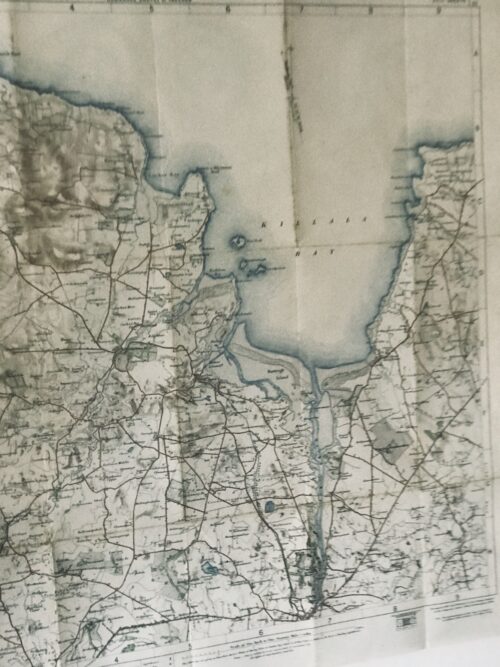
 Original ordnance survey map from 19 of Killala Bay Co Mayo in superb frame. Westport Co Mayo 65cm x 65cm Killala is a quiet seaside resort but the harbour warehouses show that it was once a busy port. This remote little town enjoys a place of disproportionate importance in the history of Ireland, as it was here that the French first halted when they invaded in 1798. The 1798 French invasion of Ireland On August 6, 1798, General Humbert’s “Army of Ireland” set sail from La Rochelle destined for Killala, Co. Mayo …
Original ordnance survey map from 19 of Killala Bay Co Mayo in superb frame. Westport Co Mayo 65cm x 65cm Killala is a quiet seaside resort but the harbour warehouses show that it was once a busy port. This remote little town enjoys a place of disproportionate importance in the history of Ireland, as it was here that the French first halted when they invaded in 1798. The 1798 French invasion of Ireland On August 6, 1798, General Humbert’s “Army of Ireland” set sail from La Rochelle destined for Killala, Co. Mayo …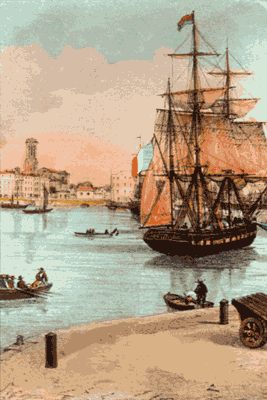
La Rochelle’s harbour.
On July 19, 1798, the French Directory authorises the sending of three expeditions to Ireland and gives command of the first one to General Humbert.
On August 6, 1798, General Humbert’s Army of Ireland sailed from La Rochelle in three frigates La Concorde, La Franchise, La Médée, carrying 1,025 French troops, 3 light field cannons, 3,000 muskets, and 400 sabres.
There were also a number of Irish among Humbert’s command. These included Bartholomew Teeling and Fr. Henry O Kane. This tiny force, together with its Irish allies, was to conduct an extraordinary campaign that shook the British Empire.During 16 days they sailed taking a circuitous route to avoid detection by the British navy. The mission of this little French expeditionary force was to provide military assistance to the Irish rebels of the “Rising of ’98” – sometimes referred to as “Bliadhan na bhFrancach” or “The Year of the French” – in their attempt to free Ireland from English domination.
The fleet had originally planned to land in Co. Donegal, but due to storm and no doubt influenced by the presence of Fr. O Kane who was a native of Killala the fleet sailed into Killala Bay.
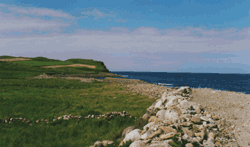
Kilcumminn head, Co. Mayo
On the 22nd of August, 1798, the three frigates landed at Kilcummin flying the English colours.
Edwin and Arthur Stock, sons of the Protestant Bishop of Killala, who had sailed out to meet them, greeted them. The two were captured, the English flag taken down and the French flag hoisted.
One of the first to disembark was Fr. O Kane who spoke to the locals in Irish which was the native tongue of most of the Irish at that time. Word soon filtered to native Irish throughout Mayo and Sligo.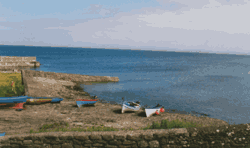
Kilcumminn strand,landing-place of the French
Bishop Stock also heard of the arrival and he sent messages to the local gentry among them the Jacksons, the Knoxs, Binghams, Palmers and Kirkwoods. Into the relative quiescence of northwest Ireland, the French expeditionary force fell like a thunderbolt. By about 7pm the landing was complete.
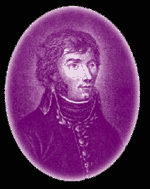
General Humbert
Young Général Jean-Joseph-Amable Humbert (the landing occurred on his 31st birthday), a canny veteran of irregular warfare against the insurgents of the Vendée, was well aware of the odds against him in a conventional military showdown, but also of the multiplying effects of surprise and speed.
He was also keenly aware of the importance of early victory for exciting the morale of the Irish insurgents and dismaying the ill-trained loyalist militia.
The first military confrontation occurred on the afternoon of 22 August, when Colonel Jean Sarrazin led a group of French Grenadiers south to the nearby village of Killala.

Killala, viewed from the north.
The garrison of 200 men included a handful of regulars of the 17th Foot (Leicestershire Regiment), but was mostly composed of the Yeomanry, an ill-trained part-time paramilitary constabulary.
With a portion of Sarrazin’s force circling around the British left flank and the remainder pressing a frontal attack with the bayonet, the unnerved Loyalists fired one ragged volley and then fled in terror towards Ballina.
Three Frenchmen were slightly wounded, bishop Stock’s palace was taken over as Humbert’s H.Q. and several of the yeomen were taken prisoner.

Ireland forever – l’Irlande pour toujours
A French soldier then climbed to the top of the palace and removed the British flag, which was replaced by a green and gold flag bearing the inscription ‘Erin Go Bragh’ (Ireland forever).
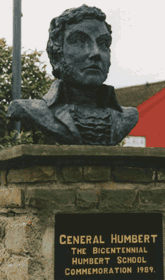
General Humbert statue in Killala.
LIBERTY, EQUALITY, FRATERNITY, UNION “After several unsuccessful attempts behold at last Frenchmen arrived amongst you . . . “Brave Irishmen, our cause is common. Like you we hold as indefeasible the right of all nations to liberty. Like you we are persuaded that the peace of the world shall ever be troubled as long as the British ministry is suffered to make with impunity a traffic of the industry and blood of the people . . . “Union, Liberty, the Irish Republic! Such is our shout. Let us march. Our hearts are devoted to you; our glory is in your happiness.”
From General Humbert’s Proclamation of 22nd August, 1798. (This last sentence of Humbert’s Proclamation became our pub’s motto!)
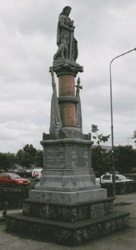
Mémorial de Ballina
This initial humbling of their oppressors had the desired effect on the local population, bringing forward thousands of eager, though ignorant and ill-disciplined Irish volunteers who were hastily equipped and formed into companies. Muskets were issued to some, but as in the uprisings elsewhere in Ireland that year, most of the insurgents were armed with crude pikes, scythes, and hay-forks.
On the 24th of August, having captured Killala, Humbert sent two groups under Sarrazin (provisionally promoted to Général de Brigade by Humbert on 23 August) and Adjudant-General Fontaine to capture Ballina.That night a fight took place between Sarrazin’s troops and the British at Rosserk. The English eventually retreated in confusion. The next morning the French/Irish troops captured Ballina under cover of darkness. The Irish peasants lit bundles of straw to show them their way. This approach road to Ballina has since been known as Bothair na Sop. They took Ballina without much resistance. The English for the most part fled towards Foxford where they would have their forces waiting for the French advance on Castlebar.
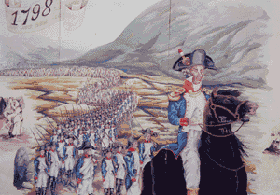
Humbert – Windy Gap Pass
The British commander in County Mayo, General Hutchinson, expected Humbert to continue south along the only decent road out of Ballina toward Castlebar, the commercial and strategic center of the region.
Where the road crosses the River Moy at Foxford, Hutchinson placed a strong blocking force with ample artillery. Clashes of French and British patrols along the Ballina-Foxford road appeared to confirm British expectations.Humbert, closely questioning the locals, learned that there was an alternative route to Castlebar, a barely-practicable goat-trail that ran west of Lough Conn, over the Windy Gap pass, and then south to the town. He resolved to take this route.
To further the deception, the Franco-Irish forces marched out of Ballina along the Foxford road at sunset on August 26 with ostentatious noise and shouted boasts of expected victory at Foxford, then doubled back in silence and darkness to the west of Loch Conn. At midnight, Humbert’s army was in Lahardane.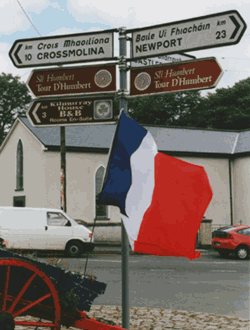
“Tour D’Humbert” signposts in Lahardane
The local priest, Father Andrew Conroy, was fluent in French from his time at seminary in Nantes.
He gave precious directions to the French officers and marshalled the people to provide food and assistance to the troops. In the aftermath of the campaign, Father Conroy was arrested, tried, and executed by the vengeful British.After a rigorous night-march of 40 km (25 miles), Humbert’s 800 French, 600 Irish, and 1 laboriously manhandled gun reached Castlebar on 27 August.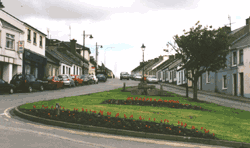
Sion Hill (now built-up)
A yeoman farmer who had been tending to his cattle had spotted the French/Irish advance party. He immediately fled to Castlebar to warn the British commander of the eminent arrival of the French/Irish forces.
The English forces took up position at Sion Hill just outside the town. Humbert approached and took account of the English position.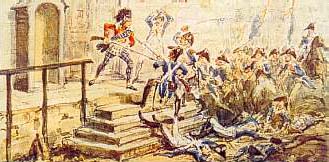
Batlle of Castlebar known as “Races of Castlebar”.
Following a number of attacks in which they were hit by British cannon, Humbert decided to regroup and divided his troops, splitting them to the left and right so as to attack the English flanks. The Irish drove a herd of cattle ahead of them causing confusion in the English rank. The French/Irish made an effective bayonet charge through the centre.
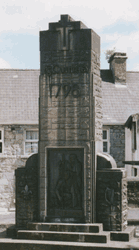
Castlebar Memorial
The English retreated down Staball Hill. Another attack occurred at Main St. Bridge. The English defended the bridge for some time using forces from the Longford and Kilkenny militias and Fraser Fencibles (a Scottish regiment).
There was confused fighting in the town as knots of the more stalwart British, notably the Fraser Fencibles and Roden’s Dragoons, attempted to make a stand.
The bulk of the redcoat forces, abandoning all guns, standards, and baggage, ran in headlong flight down the road to Tuam, 54 km (34 miles) to the southeast; some apparently did not stop until reaching Athlone, a further 68 km (42 miles) away. General Lake’s army being dissolved.
The event has since become mockingly known among the Irish as “The Castlebar Races.” In all the attack only lasted six hours from 6a.m. to 12 noon and has been described by Thomas Pakenham in The Year of Liberty as one of the most ignominious defeats in British military history. Following this brilliant victory, Humbert spent the next few days resting and reorganizing his army, absorbing many hundreds of new Irish volunteers including some 250 deserters from the Longford and Kilkenny Militias.The “Republic of Connaught” was proclaimed and a makeshift revolutionary government installed.Army of Ireland – Liberty, Equality
Head quarters at Castlebar, 14th Fructidor, sixth Year of the French Republic, One and Indivisible. General Humbert, Commander in Chief of the Army of Ireland, desirous of organizing with the least possible delay, an administrative power for the Province of Connaught, decrees as follows:
1. The Government of the Province of Connaught shall reside at Castlebar till further orders. 2. The Government shall be composed of twelve members, who shall be named by the General-in-chief of the French Army. 3. Citizen JOHN MOORE is named President of the Government of the Province of Connaught, he is specially entrusted with the nomination and reunion of the members of the Government. 4. The Government shall occupy itself immediately in organizing the Military power of the Province of Connaught, and with providing subsistence for the French and Irish Armies. 5. There shall be organized eight regiments of infantry, each of twelve hundred men, and four regiments of cavalry, each of six hundred men. 6. The Government shall declare rebels and traitors to the country all those who having received clothing and arms, shall not join the army within four and twenty hours. 7. Every individual from sixteen years of age to forty, inclusive, is REQUIRED in the name of the Irish Republic, to betake himself instantly to the French Camp, to march in a mass against the common enemy. The General Commanding-in-Chief HUMBERT.Lord Cornwallis (the same who had surrendered to Washington at Yorktown), now the Viceroy and Commander-in-Chief in Ireland, moved west from Dublin to take personal command of the campaign.It was obvious that after the fiasco of Castlebar, the Crown forces in Ireland would marshal every possible resource to crush Humbert.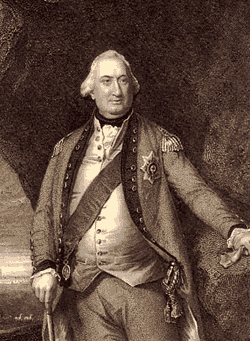
Lord Cornwallis
By the 2nd of September, Cornwallis had 7,800 men, including two reliable Scottish regiments (the Sutherland and Rehy Fencibles) concentrated at Tuam, organized into four brigades under Generals Hunter, Campbell, Hutchinson, and Moore (later the hero of Corunna), and a further 2,800 at Boyle.
Cornwallis advanced from Tuam on the 4th of September, but on arriving at Castlebar on the 5th found only a small Franco-Irish rearguard. Aware of the impossibility of defeating the well-equipped and far more numerous Crown forces, and with no sign of reinforcements from France, Humbert had marched off to the east on 4 September, under cover of darkness, taking his army, now totalling 3,000 men, towards Sligo, covering 58 miles in 36 hours. The long march had begun. Some Irish troops under French officers remained to protect Killala and receive the expected reinforcements.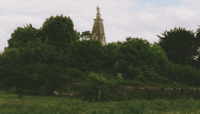
Collooney, Co. Sligo
On the morning of the 5th of September, an English army from Sligo under Col Vereker attacks the Franco-Irish army at Collooney with its left protected by the Ballysadare River and its right anchored on a steep, wooded hill. Humbert again outmanoeuvres them.
In what may be one of the greatest feats of individual bravery in the long history of the Revolutionary and Napoleonic Wars, Colonel Bartholomew Teeling, a United Irishman holding a French commission, galloped forward alone to the British line, pistolled the enemy gunner at point-blank range, and rode back unscathed under a hail of musket-fire. Inspired by his example, the Irish and French surged forward and routed the Loyalists. The English retreated with heavy losses as far as Ballyshannon, County Donegal.Cornwallis has now divided his army in two, one half under General Lake to pursue the enemy and the other half, under his own personal command, to protect the line of the river Shannon.
Ballinamuck pikeman
The French and Irish “must not cross”. Meanwhile, the United Irishmen of Longford and Westmeath have assembled. They capture Wilson’s Hospital near Mullingar but fail to take the town of Granard. Humbert, on hearing of the midlands rising decides to link up with the insurgents there.He is now near Manorhamilton but changes and goes straight for Granard. He abandons some of the heavier guns so as to make more speed. So far he has eluded the cordon closing in around him. With some luck he hopes to slip past the net, reach Granard and then strike for Dublin which is virtually unprotected as most of the garrison have been moved to Connacht. The Franco-Irish army reaches Drumkeerin in the evening of September 6. An envoy from Lord Cornwallis offers terms for surrender but they are rejected.On September 7, shortly before noon Humbert’s army crosses the Shannon at Ballintra Bridge just south of Loch Allen, but they fail in an attempt to demolish the bridge behind them.
His army shows signs of fatigue and skirmishes with the English advance guard become more frequent. The race for Granard quickens.
The Franco-Irish army reaches Cloone, in South Leitrim, while Cornwallis, with 15,000 men is at Mohill, five miles away. Humbert gets news that he is surrounded and outnumbered but decides to push on even if the best he can now do is to make a token resistance before surrender.On September 8, 1798, near the small village of Ballinamuck, County Longford, Humbert drew up his 859 French troops in line of battle. There could be little doubt of the outcome.
Behind Humbert was Cornwallis blocking Humbert’s way to Dublin. In front was Lake’s 6000 men. The battle which lasted but half an hour commenced with Colonel Crawford’s dragoons cutting through the Irish rebels. When the British grand assault poured up the hill from three sides, in overwhelming numbers, Humbert gave the order to surrender.
Humbert surrenders in Ballinamuck
The French officers followed their general’s signal and ordered their men to lay down their muskets. A second body of British cavalry had reined in seeing the signs of surrender, but Colonel Teeling, an Irish officer in the French army, had not signaled surrender so British infantry advanced on them. Crawford attacked a large contingent of Irishmen with his dragoons, their sabres sparing only those with officers insignia, hanging to be their fate.
Later testimonies reveal that on arresting Humbert, General Lake could not conceal his astonishment: “Where is your army?” Lake demanded “This is it all” Humbert replied, indicating his soldiers. “And what were you planning to do with this lot?” Lake asked. “We were going to Dublin to break the irons of a nation that suffers under your yoke” Humbert said. “That is an idea that could only be born in a Frenchman’s brains!” Lake declared.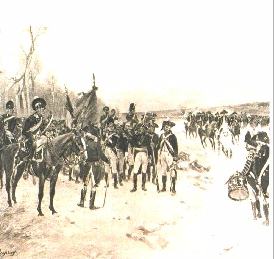
Humbert surrenders in Ballinamuck
Humbert and the French prisoners were conducted to Dublin and treated with all the consideration that could be given to gallant prisoners after an honorable defeat.
Not so the Irish. Accounts vary, but it appears that many of the Irish were cut down where they stood, or driven into the bog south of the hill where they were hunted down and slaughtered. Captured Irish officers, even those bearing legitimate commissions in the French army, were seized and hanged as traitors. Such was Bartholomew Teeling, Matthew Tone and Gunner James Magee’s fate.“After having obtained the greatest successes and made the arms of the French Republic triumph during my stay in Ireland, I have at length been obliged to submit to a superior force of 30,000 troops.” General Humbert’s Report to the French Directory after Ballinamuck.
‘A SHORT BUT VERY FATIGUING CAMPAIGN’
English historians have always treated General Humbert’s expedition to Ireland with ridicule, but Brian O hUiginn was fond of quoting Plowden the military correspondent of the London Times who held a different view. This expert wrote some years ago:
“In these operations described by Cornwallis to the Duke of Portland as a short but very fatiguing campaign, a raiding party of 1000 French landed in Ireland without opposition, after sixteen days of navigation, unobserved by the British Navy; defeated and drove back the British troops opposing them on four separate occasions; routed a force of second line troops of at least double its strength; captured eleven British guns; held the field for seventeen days; entirely occupied the attention of all the available troops of a garrison of Ireland 150,000 strong; penetrated almost to the centre of the island, and compelled the Lord Lieutenant to send an urgent requisition to London for ‘as great a reinforcement as possible.’ “
This was a fine tribute to General Humbert and his troops.- In Humbert’s footsteps 2013 – Killala & Castlebar
- In Humbert’s footsteps 2013 – Killala & Castlebar
- In Humbert’s footsteps 2013 – Killala & Castlebar
- In Humbert’s footsteps 2013 – Killala & Castlebar
The Charentais of the expedition.
Many Charentais took part in the expedition. Among them: Daniel Savary, who was born in Salles sur Mer (17), was in command of the naval division charged with transporting the expedition from La Rochelle to Killala. François Babin, born in Péré (17), became Commander of the Castlebar battalion. Jean Jobit, born in Chateauneuf en Charente (16), was a Commander on the Castlebar battlefield in Castlebar. Jean-Paul Leugerat, born in Barbezières (16), died during the battle of Castlebar. -

 Fascinating map from 1610 as by the renowned cartographer John speed of the Province of Mounster(Munster!)-comprising the counties of Tipperary,Clare,Limerick,Cork,Kerry & Waterford.Includes miniature city layouts of both Limerick & Cork. 52cm x 65cm Beaufort Co Kerry John Speed (1551 or 1552 – 28 July 1629) was an English cartographer and historian. He is, alongside Christopher Saxton, one of the best known English mapmakers of the early modern period.
Fascinating map from 1610 as by the renowned cartographer John speed of the Province of Mounster(Munster!)-comprising the counties of Tipperary,Clare,Limerick,Cork,Kerry & Waterford.Includes miniature city layouts of both Limerick & Cork. 52cm x 65cm Beaufort Co Kerry John Speed (1551 or 1552 – 28 July 1629) was an English cartographer and historian. He is, alongside Christopher Saxton, one of the best known English mapmakers of the early modern period.Life
Speed was born in the Cheshire village of Farndon and went into his father Samuel Speed's tailoring later in life. While working in London, Speed was a tailor and member of a corresponding guild, and came to the attention of "learned" individuals. These individuals included Sir Fulke Greville, who subsequently made him an allowance to enable him to devote his whole attention to research. By 1598 he had enough patronage to leave his manual labour job and "engage in full-time scholarship". As a reward for his earlier efforts, Queen Elizabethgranted Speed the use of a room in the Custom House. Speed, was, by this point, as "tailor turned scholar" who had a highly developed "pictorial sense". In 1575, Speed married a woman named Susanna Draper in London, later having children with her. These children definitely included a son named John Speed, later a "learned" man with a doctorate, and an unknown number of others, since chroniclers and historians cannot agree on how many children they raised. Regardless, there is no doubt that the Speed family was relatively well-off. By 1595, Speed published a map of biblical Canaan, in 1598 he presented his maps to Queen Elizabeth, and in 1611–1612 he published maps of Great Britain, with his son perhaps assisting Speed in surveys of English towns. At age 77 or 78, in August 1629, Speed died. He was buried alongside his wife in London's St Giles-without-Cripplegate church on Fore Street. Later on, a memorial to John Speed was also erected behind the altar of the church.According to the church's website, "[His was] one of the few memorials [in the church] that survived the bombing" of London during The Blitz of 1940–1941 ... The website also notes that "[t]he cast for the niche in which the bust is placed was provided by the Merchant Taylors' Company, of which John Speed was a member". His memorial brass has ended up on display in the Burrell Collection near Glasgow.Works
Speed drew historical maps in 1601 and 1627 depicting the invasion of England and Ireland, depictions of the English Middle Ages, along with those depicting the current time, with rough originals but appealing, colourful final versions of his maps. It was with the encouragement of William Camden that Speed began his Historie of Great Britaine, which was published in 1611. Although he probably had access to historical sources that are now lost to us (he certainly used the work of Saxton and Norden), his work as a historian is now considered secondary in importance to his map-making, of which his most important contribution is probably his town plans, many of which provide the first visual record of the British towns they depict.In the years leading up to this point, while his atlas was being compiled, he sent letters to Robert Cotton, part of the British government to ask for assistance in gathering necessary materials.His atlas The Theatre of the Empire of Great Britaine was published in 1611 and 1612, and contained the first set of individual county maps of England and Wales besides maps of Ireland and a general map of Scotland. Tacked onto these maps was an introduction at the beginning when he addressed his "well affected and favourable reader", which had numerous Christian and religious undertones, admitting that there may be errors, but he made it the best he could, and stated his purpose for the atlas:my purpose...is to shew the situation of every Citie and Shire-town only [within Great Britain]...I have separated...[with] help of the tables...any Citie, Towne, Borough, Hamlet, or Place of Note...[it] may be affirmed, that there is not any one Kingdome in the world so exactly described...as is...Great Britaine...In shewing these things, I have chiefly sought to give satisfaction to all.
With maps as "proof impressions" and printed from copper plates, detail was engraved in reverse with writing having to be put on the map the correct way, while speed "copied, adapted and compiled the work of others", not doing much of the survey work on his own, which he acknowledged.The atlas was not above projections of his political opinions" Speed represented King James I as one who unified the "Kingdoms of the British isles". In 2016, the British Library published a book, introduced by former MP Nigel Nicolson and accompanied by commentaries by late medieval and early modern historian Alasdair Hawkyard, which reprinted this collection of maps on the British Isles, showing that Speed had drawn maps of areas ranging from Bedfordshire to Norfolk and Wales. Most, but not all, of the county maps have town plans on them; those showing a Scale of Passes being the places he had mapped himself. In 1627, two years before his death, Speed published Prospect of the Most Famous Parts of the World which was the first world atlas produced by an Englishman, costing 40 shillings, meaning that its circulation was limited to "richer customers and libraries", where many survive to this day. There is a fascinating text describing the areas shown on the back of the maps in English, although a rare edition of 1616 of the British maps has a Latin text – this is believed to have been produced for the Continental market. Much of the engraving was done in Amsterdam at the workshop of a Flemish man named Jodocus Hondius, with whom he collaborated with from 1598 until 1612, with Hondius's sudden death, a time period of 14 years.His maps of English and Welsh counties, often bordered with costumed figures ranging from nobility to country folk, are often found framed in homes throughout the United Kingdom. In 1611, he also published The genealogies recorded in the Sacred Scriptures according to euery family and tribe with the line of Our Sauior Jesus Christ obserued from Adam to the Blessed Virgin Mary, a biblical genealogy, reprinted several times during the 17th century. He also drew maps of the Channel Islands, Poland, and the Americas, the latter published only a few years before his death. On the year of his death, yet another collection of maps of Great Britain he had drawn the year before were published. Described as a "Protestant historian", "Puritan historian" or "Protestant propagandist" by some, Speed wrote about William Shakespeare, whom he called a "Superlative Monster" because of certain plays, Roman conquest, history of Chester, and explored "early modern concepts of national identity". As these writings indicate, he possibly saw Wales as English and not an independent entity. More concretely, there is evidence that Speed, in his chronicling of history, uses "theatrical metaphors" and his developed "historiographic skill" to work while he repeats myths from medieval times as part of his story.Legacy
Since his maps were used in many high circles, Speed's legacy has been long-reaching. After his death, in 1673 and 1676, some of his other maps on the British isles, the Chesapeake Bay region, specifically of Virginia and Maryland, the East Indies, the Russian Empire then ruled by Peter the Great, Jamaica, and Barbados, among other locations.With these printings and others, Speed's maps became the basis for world maps until at least the mid-eighteenth century, with his maps reprinted many times, and served as a major contribution to British topography for years to come. In later years, Speed would be called "our English Mercator", a person of "extraordinary industry and attainments in the study of antiques", an "honest and impartial historian", a "faithful Chronologer", and "our Cheshire historian...a scholar...a distinguished writer on history".He was also called a "celebrated chronologer and histographer", "cartographer", and much more. Even today, prints of his "beautiful maps" can be found in living rooms across the world, and sell for hundreds of thousands of pounds in rare art and map auctions, drawing in map collectors across the globe.Additionally, some use John Speed's maps, and connected commentary, to interpret William Shakespeare's plays; however, Speed did not like Shakespeare in the slightest, and called him a "papist".

